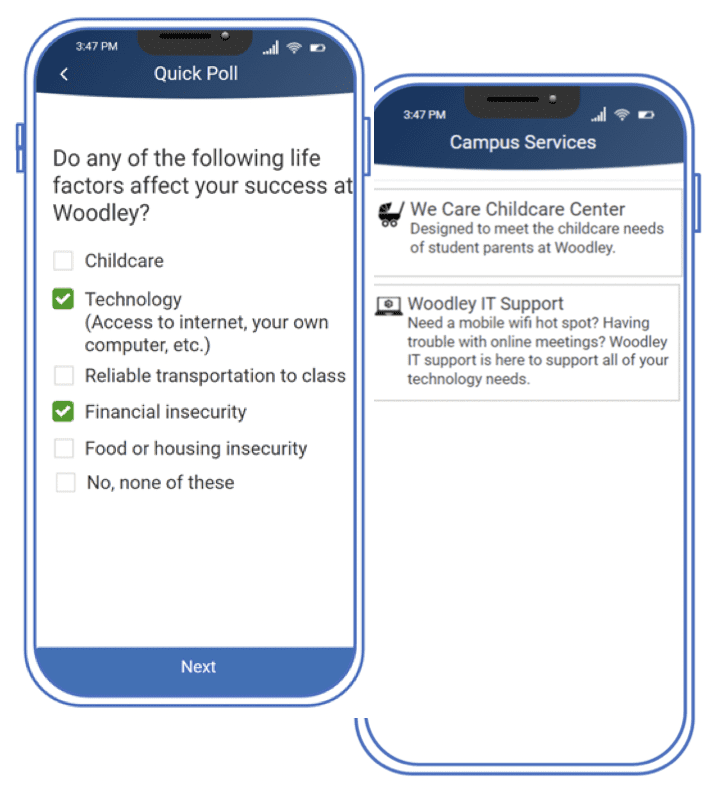3 ways to combat the community college enrollment decline
July 21, 2022
Community colleges are facing steeper enrollment drops than any other higher education segment: since the spring of 2021, community colleges have accounted for more than half of the 5% enrollment decline among public institutions. These trends have been exacerbated by “The Great Opt-Out” among traditional college-aged students and dropping transfer rates-and while Federal relief dollars helped stave off the financial impact of this enrollment decline, many leaders are now looking for more sustainable solutions.
In this blog, I’ll cover three ways community colleges can invest their resources to enroll more students and retain the students they have, sourced from EAB’s work with our community college partners.
A steep enrollment drop
827,000
Community colleges lost over 827,000 students since the pandemic's start, according to the National Student Clearinghouse Research Center3 ways to combat enrollment decline
1. Streamline onboarding
Community colleges require students to navigate complex processes and policies when it comes to admissions and onboarding. Some colleges report losing over half of their applicants before the first day of class as mazes of offices, forms, and new terms discourage students and delay their progress toward enrollment. And the pandemic only augmented those issues as certain parts of the process became virtual.
Incoming students met with a maze of onboarding steps

This is an area where community colleges can learn from for-profit institutions, who are incentivized to get as many students as possible through onboarding and into class. EAB audited the for-profit onboarding process and one thing stood out: every staff member who interacts with students acts as an advisor. Everyone knows the steps of the onboarding process and can direct students effectively, preventing the frustrating experience of being referred from office to office and person to person. Ensuring staff have a baseline degree of knowledge about the entirety of the enrollment process creates a more seamless experience for students.
Improving Applicant-to-enrollee Conversion: Read The Case Study
2. Recruit back your stopouts
Stopouts are students who were once enrolled but do not return the next semester. Many community college students are juggling competing priorities, which can make college success feel out of reach and lead students to “press pause” on their higher education journey. Engaging with these stopouts is critical, as it could be the difference between a student eventually completing a credential or dropping out altogether.
We know putting effort into re-enrollment campaigns pays off. Data shows that more than half of all students who stopped out return within a year. Additionally, students who re-enroll after stopping out are more likely to graduate than not, even if they are out of school for multiple years.
The goal with re-enrollment is to open lines of communication and reengage the student. There are plenty of simple incentives that come at a low cost to the institution but have a large effect on recruiting back stopouts:
- No(re)application fee: Eliminate financial barriers and create time-sensitive action
- Simplified (re)application: Streamline application and processing to eliminate barriers
- Priority registration: Demonstrate commitment to graduate returning students
- Free parking: Incentivize off-peak enrollment, which is when most returning students enroll
- Personalized graduation plan: Reveal a course path to graduation in their original major or a new one
Incentivizing stopouts to re-enroll is not only a promising method for increasing enrollment; it also allows institutions to deliver on their unfulfilled promise to these students.
3. Provide just-in-time support for students
The increased flexibility of course delivery that developed over the last two years should be met with additional support to address students’ needs beyond academics. Between a volatile employment market, increased cost of living, and widening equity gaps, the pandemic created or increased financial pressure on many, especially students and potential students: adults aged 18 to 34 are three times more likely to experience pandemic-related financial stress. Technology can help institutions scale their efforts to put students in touch with the right supports at the right time.
For example, our community college partners survey students with Navigate to learn about their needs, goals, and worries as the year begins (pictured here). The institutions automatically share relevant resources based on students’ responses, and advisors can customize their interactions with each student from the beginning. The Navigate app also helps students stay on track academically, find ways to get involved socially, and plan for future semesters via checklists, alerts, and more.
Once students start the semester, technology can help faculty and staff coordinate and scale their response when students need mental health or other support. Lake Washington Institute of Technology (LWTech) uses the Starfish technology platform to nudge faculty every quarter to submit an alert for students they are concerned about for any reason. The alerts are managed in a way that ensures advisors, counselors, and other staff can provide a coordinated response and have the insight they need to prioritize students in greater need of help.

Video: LWTech Leaders Discuss Building a Community Of Care
Tips for rolling out new support resources
When launching a new student support resource on your campus, here are some tips when rolling out to faculty and staff:
- Hyperlink directly to resource details
- Provide a brief description of the service and its purpose
- list situations in which faculty/staff should refer students
- List who is served by which services
- Provide general contact info and a staff contact for additional information
It’s time for a new support infrastructure
I’m passionate about the mission of community colleges, knowing the important role they play in educational access and social mobility. But the balance between mission and financial sustainability has never felt more precarious. Given the breadth of the student needs and goals that community colleges cater to, there may be no silver bullet to counteract the enrollment decline. Instead, we need to invest in small changes and tools to create a more holistic, personalized student support infrastructure that will make it easier for students to enroll and re-enroll at our institutions-regardless of the external factors at play.
More Blogs

Four ways community colleges can improve career readiness

Beyond ROI: What the New Fed Data Misses About Higher Ed’s Value Crisis

Revitalize your athletics portfolio in a tumultuous landscape
Great to see you today! What can I do for you?